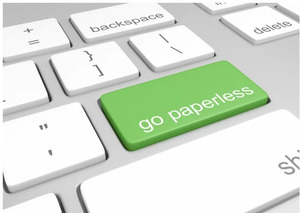Paperless Pay: Know Benefits And Features
Body
Paperless pay is a method of paying employees electronically, without paper checks or cash. It can also refer to online access to payment-related information, such as pay stubs, tax forms, and benefits statements. It is becoming more popular among employers and employees, offering many advantages over traditional payment methods. This article will explain what paperless pay is, how it works, and what benefits it provides.
Paperless Pay:
Paperless pay transfers money from an employer's bank account to an employee's account using an electronic medium such as direct deposit, payroll card, or mobile wallet. It eliminates the need for printing, mailing, or cashing paper checks, which can be costly, time-consuming, and prone to errors or fraud.
Paperless pay allows employees to access payment information online. Employees can see their pay stubs, tax forms, benefits statements, and other documents anytime and anywhere. They can also download or print their documents if they need a hard copy.
How Does Paperless Pay Work?
Paperless pay uses an electronic funds transfer (EFT) system that moves money from one bank account to another. The most common EFT system for paperless pay is direct deposit, which deposits the employee's net pay directly into their bank account on payday.
Another EFT system is the payroll card, a prepaid debit card that the employer loads with the employee's net pay on payday. Employees can use the payroll card to withdraw cash from ATMs, purchase at stores, or pay bills online. The employee does not need a bank account to use a payroll card.
A newer EFT system is a mobile wallet, a digital version of a physical wallet. Employees can use the mobile wallet to make contactless payments at stores or online. Employees must link their bank account or payroll card to their mobile wallet to use it.
Paperless Pay: Benefits
Paperless pay offers many benefits for both employers and employees, such as:
Cost savings: It reduces the expenses of printing, mailing, processing, and reconciling paper checks. According to a report by NACHA, the average cost of issuing a paper check is $3.15, while the average cost of issuing a direct deposit is $0.35.
Time savings: Paperless pay eliminates the delays and hassles of waiting for paper checks to arrive in the mail or clearing in the bank. Employees can access their money faster and easier with paperless pay.
Security: It reduces the risk of lost, stolen, or forged paper checks, which can result in identity theft or fraud. Employees can also protect their personal information using passwords or biometrics to access their online accounts or mobile wallets.
Convenience: Paperless pay allows employees to choose their preferred payment method and bank account. Employees can access their payment information online anytime and anywhere without keeping track of paper documents.
Environmentally friendly: It reduces the environmental impact of paper production, transportation, and disposal. According to a report by PayItGreen, if every U.S. worker switched from paper checks to direct deposit, it would save 1.8 million trees and 12 billion gallons of water per year.
Conclusion
Paperless pay is a modern and efficient way of paying employees electronically, without using paper checks or cash. Paperless pay enables employees to access payment information online. It is becoming more popular among employers and employees, offering many advantages over traditional payment methods.













Comments